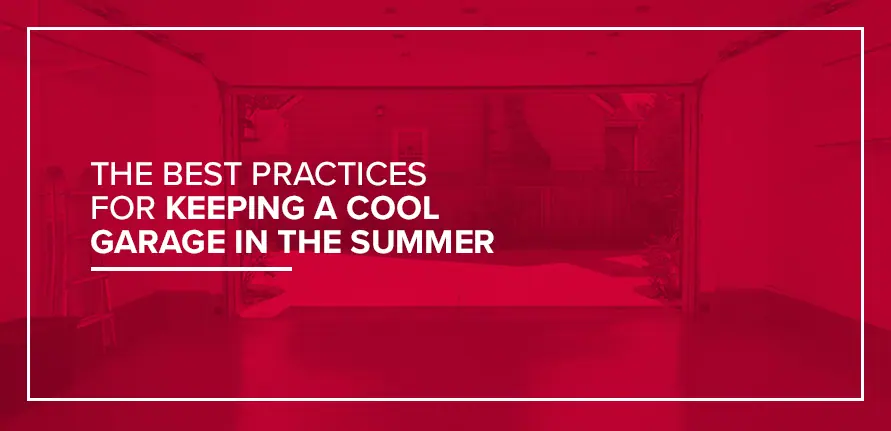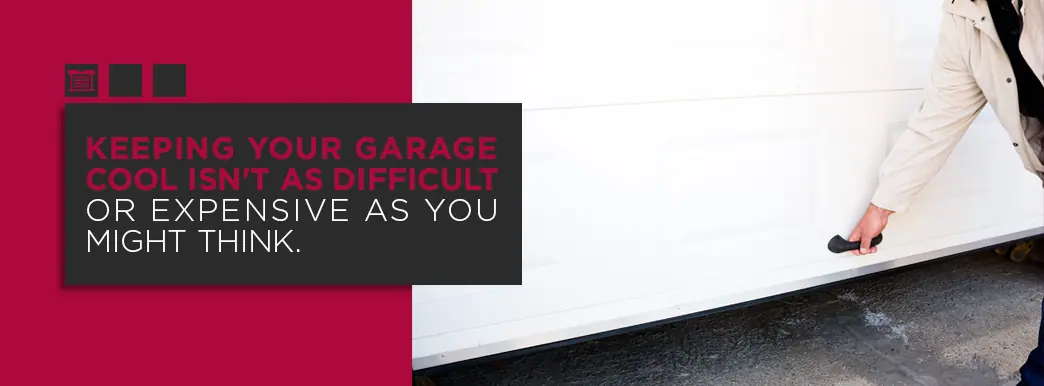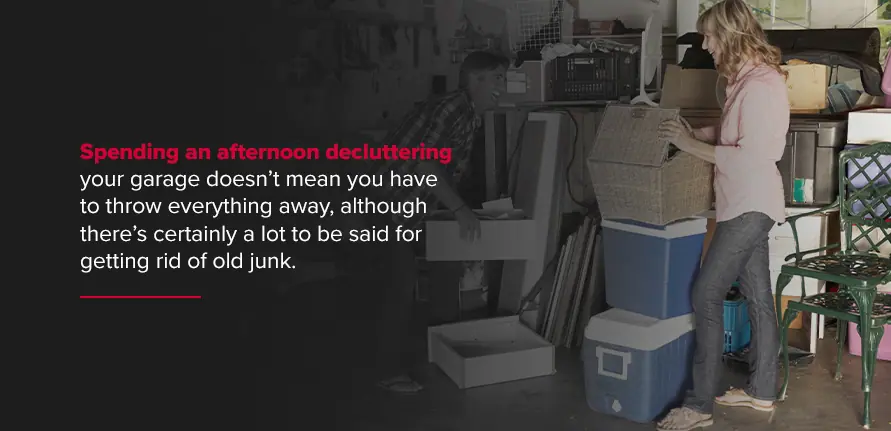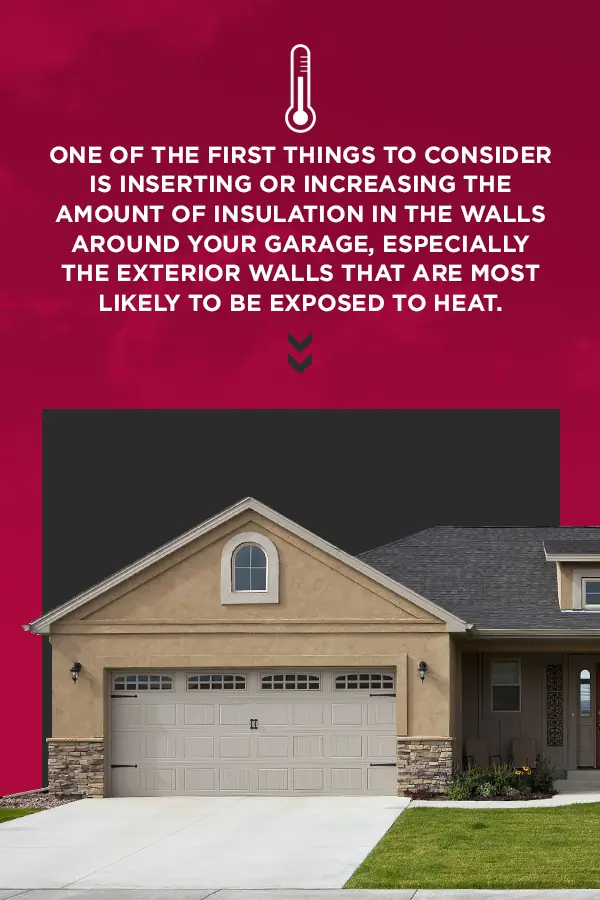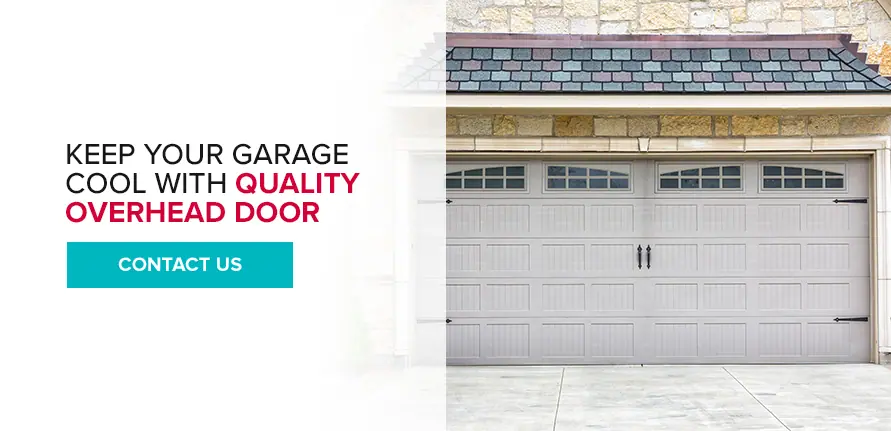Are you looking for ways to make your home more energy efficient? One way you can lower your energy bills is to buy more efficient appliances, upgrade your fixtures and plug any air leaks.
If you live somewhere prone to hot summers and cold winters, you’ve probably spent a lot of time — and possibly money — accomplishing these tasks. However, if you’re like most homeowners, your repairs and upgrades have been focused on your primary living space, and you’ve probably overlooked one crucial area of your home — the garage.
During those hot summer months, the heat in your garage can quickly become unbearable. If you’re a homeowner whose garage also doubles as a workspace or hobby shop, high temperatures mean a lot of sweating and discomfort. You might avoid working on projects, and you’ve probably asked yourself “Why is my garage so hot?” as you wipe the sweat off your face and head inside in search of a cold beverage.
Even the most energy-efficient home often has a garage that seems to rival oven temperatures during hot summer months — but it doesn’t have to be that way.
How to Cool Your Garage
Keeping your garage cool isn’t as difficult or expensive as you might think. In fact, you may not have to spend any money at all to bring down the temperatures in your garage. Consider trying one — or several — of these great options if you’re wondering how to keep your garage cool.
1. Open the Door
When it comes to knowing how to keep your garage cool, the first — and often best — step is to open the garage door. This is an ideal way to ventilate a hot garage and let some of that trapped air escape. If your garage door faces north, you’ll find that opening the door lets in cooler air because the northern side of your property gets less sunlight, which means lower temperatures. Even if your garage doesn’t face north, opening it typically brings in a breeze. Air that’s moving will be cooler than air that stands still.
If your garage has windows, consider opening them as well. Opening the doors and windows creates a cross-breeze that cools your garage more quickly than if you only open a door. Leaving the windows open can make your space more comfortable. Just remember to close the windows when you go inside or leave the residence. Leaving the windows open without supervision poses a safety risk.
If you’re someone who doesn’t want their neighbors walking by and peering into their garage, you can still open doors and windows to cool things off. Rather than opening your garage door all the way, raise it a foot or two off of the ground. Combined with open windows, this will still get cooler air inside, making it more comfortable for you to work, but still maintaining the privacy you crave.
One word of caution — if you’re looking for ways to create a cross breeze in the garage, avoid the temptation to do this by opening the door that connects your garage to your home. While it may increase airflow, what you’ll end up doing is creating the opportunity for potentially toxic fumes to travel from the garage into your home. You never want to expose your family to these fumes, even in small amounts.
2. Cool Vehicles Before Parking
When you drive your car, it heats up. If you park it in the garage immediately after you arrive home, that heat will warm up the air in your garage. If the garage door is closed, all of that hot air remains trapped inside of the garage, raising the overall temperature of your space.
Rather than driving straight into your garage, consider leaving your car to cool off in the driveway. If your driveway is shaded, your car should be cool an hour or two later, and you can then drive it into the garage. If your driveway gets a lot of sunshine, this may not work since the sun will continue to heat the car when it’s parked. If you want to cool your car off, but leaving it in the driveway isn’t an option, consider pouring cold water on the roof of the car to speed up the cooling process before moving it into the garage.
3. Install a Ceiling Fan
Another way to cool your garage is to install a ceiling fan. It’s a cost-effective and simple solution for improving the temperature of your space. However, it’s only possible to install a ceiling fan in a garage with a ceiling height of at least eight feet. If your garage ceiling is lower, it’s a bad idea to install a fan because it may interfere with your garage door opening or closing or potentially prevent you from parking a taller vehicle in the space.
Ceiling fans work best when their blades are located seven to nine feet from the floor, with about 10-12 inches of space under the ceiling. Keep the dimensions of your garage in mind when you’re shopping for a fan to install. The larger the fan, the more it can cool your space, but a fan that’s 36-44 inches in diameter should be sufficient for any garage that’s smaller than 225 square feet.
Look for a fan with an ENERGY STAR rating to improve the overall efficiency of your garage and your home. If your garage is over 225 square feet in size, you’ll want to purchase a fan that is 52 inches or more in diameter. If you have a large garage and it’s more than 18 feet long, consider installing more than one fan to evenly distribute coverage over the space.
If you have windows in your garage, you may also want to consider installing a window fan to draw cooler air into the garage or expel hot air from the space. This feature can help your garage start to feel like any other room in your house, even on hot days.
4. Declutter
It may seem silly, but a garage full of stuff could be raising the temperature inside. How? If you have boxes stacked around the garage, they can retain heat along the floor and prevent airflow. Even if you open the windows or the door, the air is unable to flow around them, creating a hot, stagnant space.
Spending an afternoon decluttering your garage doesn’t mean you have to throw everything away, although there’s certainly a lot to be said for getting rid of old junk. In many cases, simply improving the organization of your garage will be enough to improve the airflow. If you don’t want to throw away the contents of those boxes, get them up off the floor and onto shelves. Make sure your belongings aren’t piled up in front of windows or doors you want to open, too.
If you discover more old stuff than you know what to do with, have a garage sale to get rid of some of the items in storage. Decluttering your garage space does more than keep the temperature in check — it also makes it easier to park your vehicle and move from one end of the room to the other.
5. Install an Awning or Plant a Tree
You can purchase and install a roll-away awning that can be pulled down to block the sun during the hot summer months. When the awning is in place, it can shade your garage door from the strong rays of the sun and keep the air temperature around your garage door significantly cooler. During the winter months, the awning can be rolled back and stored, protecting it from damage from weather, as well as allowing your garage to get more sunlight and heat when it’s cold.
In some cases, you may even be able to incorporate a permanent awning into the design of your home. While this may not be an inexpensive solution, it can be a visually appealing solution to an ongoing problem, especially if your garage doors face directly into the sun during the hottest part of the day.
An awning is a practical solution, but if you’re looking for something more visually appealing or less expensive, then another option is to strategically plant a deciduous tree between the garage and the sun. A deciduous tree is one that’s going to be full of leaves during the hot summer months and then lose all its leaves in the fall, leaving a direct path for the sunlight to warm the area around your garage door during winter. Types of trees to consider include ash, oak and walnut.
6. Improve Insulation
While there are many garage cooling ideas that help you beat the heat once it’s there, one of the best ways to keep your garage cool is to prevent the heat from building up in the first place. You can do this by improving the insulation in and around your garage. You can improve your garage’s insulation without spending a lot of money on materials or contractor fees, but some solutions are more affordable than others.
One of the first things to consider is inserting or increasing the amount of insulation in the walls around your garage, especially the exterior walls that are most likely to be exposed to heat. If your garage already has drywall in place, you can consider blown-in insulation. If your garage isn’t finished and doesn’t have drywall, then consider installing Batt insulation. It’s cheap and easy to install, but you’ll want to cover it with drywall to prevent children or pets from messing with it.
Another option is to install new weatherstripping around your garage door and the windows. This fix is an affordable way to insulate your garage without extensive labor, and it may be especially effective if your home is older, since the weatherstripping that’s already in place has likely worn out after years of use. New weatherstripping will improve the garage’s seal, preventing hot air from slipping in through cracks and crevices around the door or windows.
Working on the ceiling of your garage is also an option to improve your garage’s overall insulation, especially if your garage ceiling isn’t finished. You can take this opportunity to finish the ceiling with drywall, but if you don’t want to spend the money or time on an extensive project, you can simply staple Batt insulation along the ceiling. Set the Batt insulation in place using netting designed to hold it where you want it.
Another ideal way to improve your garage’s insulation is to replace your existing garage door with an insulated garage door. An insulated garage door is similar to a standard garage door, except that it’s constructed with one or more layers of insulation in between the panels of the door. The insulation inside of the door is designed to block outside air from penetrating the door and making its way into your garage. In other words, an insulated garage door is designed to keep hot air out in the summer and cold air out in the winter.
What’s so great about an insulated garage door?
- Improves the energy efficiency in your garage and your home by blocking hot air from entering your garage. In the winter months, it also prevents cold air from entering your space.
- Protects your car and other mechanical equipment, such as lawnmowers, air compressors and more, from damage that comes from exposure to extreme temperatures.
- Keeps your hobby shop or garage workspace cool in the summer and warm in the winter. No one wants to give up a hobby they love because it’s too hot to work!
- Lasts longer because of its durable, multi-layer construction.
- Blocks unwanted noise, which is a great bonus if you live in the city or have a family member who comes and goes at unusual hours.
In other words, when you purchase an insulated garage door, you’re guaranteeing a more even temperature inside of your garage, as well as comfort for your entire home and the loved ones who live there. An insulated door allows you to store important equipment in the garage, and it even improves the temperature of your garage enough that you can work out there when it’s warm — or cold.
Keep Your Garage Cool With Quality Overhead Door
When it comes to keeping your garage comfortable during the summer months, there are a lot of low-cost options out there. Opening the door, installing a fan or improving your garage’s insulation are all great ways to keep from turning your garage into an oven when the mercury starts to rise.
If you try these ideas and you’re still having trouble keeping your garage comfortable, then it’s time to call the professionals at Quality Overhead Door. Serving the Toledo area since 1982, Quality Overhead Door is committed to providing our customers with quality service that meets their needs each and every time. We don’t just service the doors we install, either. If you have an older door that’s giving you problems, let us take a look. If you have a newer door that needs repair, give us a call. And, of course, if you’re in the market for a new garage door, we’d like to help you find the one that will meet your needs and take your house from good to great.
In the market for garage door repairs or replacement? Want to know more about our services? Give us a call today!
Additional Resources on Seasonal Garage Door Tips:
- How Does Summer Weather Affect Your Garage Door?
- 3 Ways to Have a Warm Garage This Winter
- How Does Winter Affect Your Garage Door?
- Garage Door-Friendly Ice and Snow Removal Tips

